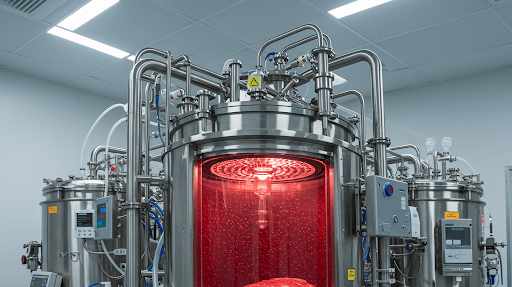The Self-Optimizing Bioreactor: How AI is Unlocking Consistent, High-Yield Food Fermentation
SUSTAINABILITYALTERNATIVE PROTEINSFROZEN FOOD


This is an AI generated illustration and does not represent actual product or service.
If you work in food fermentation, you know the challenge: it's more art than science. Despite being one of the oldest food processing technologies, industrial-scale fermentation remains notoriously difficult to control. It's a "black box" where nonlinear dynamics, time delays, and tightly coupled parameters (where adjusting pH affects dissolved oxygen, which affects bacterial growth) make consistent, high-yield results elusive.
A new patent from researchers at Jimei University and Jiangsu University (US20240392229A1) aims to turn that art into a precise science. They have developed a data optimization method and system that uses advanced machine learning to not just model, but actively and autonomously optimize the food fermentation process in real-time.
The Multi-Billion Dollar Problem in the Bioreactor
Why has fermentation been so resistant to automation? The patent outlines the core issues:
The "White-Box" Model Failure: Creating first-principles models based on fermentation mechanics is incredibly complex and often impractical due to countless biological variables.
The "Black-Box" Model Limitation: While data-driven models are easier to build, they often fail to deeply mine the complex, multi-scale patterns within process data, leading to suboptimal predictions.
The Coupling Effect: This is the critical bottleneck. You can't optimize for one parameter (e.g., bacterial concentration) in isolation. A change triggers a cascade of other effects, making the process unstable and preventing true holistic optimization.
This patent tackles these problems head-on with a sophisticated AI pipeline that acts as the brain for a "self-optimizing" bioreactor.
The Tech Deep Dive: An AI Pipeline for Fermentation
The system operates in three powerful stages:
1. Smarter Data Foundation
Instead of just collecting data (temperature, pH, DO, bacterial concentration, substrates), the system structures it intelligently. It couples process data at time t with the target value at t+1, teaching the model to forecast future states. It then uses a novel Input-Output Cooperative Distance Classification (IOCDC) method to split data into training and test sets, ensuring robustness and preventing model bias from the start.
2. The Secret Sauce: Multi-Scale Feature Extraction (MCFF)
This is the core innovation. The Multi-scale Cross-correlation Feature Filter (MCFF) acts like a powerful lens to see patterns in data that were previously invisible.
It uses multiple filters of different sizes to analyze process data at various scales or resolutions.
Each filter module includes normalization and activation functions to stabilize learning and capture non-linear relationships.
Crucially, it then employs a "Collaborative Hybrid" step to fuse these multi-scale features. The most effective method, Convolutional Collaborative Hybrid, lets the system itself learn the optimal way to combine these features, creating a rich, high-level understanding of the process dynamics.
3. Closed-Loop, Real-Time Optimization
This is where the magic happens. The extracted features feed a predictive model. But instead of just displaying a prediction, the system closes the loop:
The Digital Twin: The predictive model acts as a real-time digital simulation of the fermentation.
The Optimizer: A meta-heuristic algorithm (like a Genetic Algorithm) tests thousands of control parameter combinations (pH, DO setpoints) against the digital twin to find the perfect recipe to achieve a goal—e.g., "maximize bacterial concentration in the next 2 hours."
The Execution: The optimal parameters are automatically sent to the bioreactor's control systems. This cycle repeats at every sampling interval, creating a continuous, adaptive feedback loop that actively counters process deviations and coupling effects.
Proof is in the Kombucha: Tangible Results from a Real-World Test
The patent validates the system using a kombucha fermentation, a complex process with clear commercial relevance.
Unprecedented Model Accuracy:
C-source prediction model saw a 42.3% improvement in accuracy.
Bacterial concentration prediction model saw a 63.7% improvement in accuracy.
These aren't marginal gains; they represent a step-change in our ability to monitor a fermentation process.
Successful Autonomous Optimization:
The system was tasked with three control strategies:Optimize Bacterial Growth: It successfully found pH/DO profiles to increase cell density.
Optimize Substrate Consumption: It accelerated the consumption of the carbon source, improving efficiency.
Segmented Optimization: It automatically switched strategies mid-fermentation from maximizing growth to optimizing production, demonstrating sophisticated, adaptive control that mirrors expert decision-making.
The Bottom Line for the Food Industry
This technology is not just a academic exercise; it has direct and profound implications:
For R&D and Production Teams: Achieve unprecedented batch-to-batch consistency, reduce failed batches, and accelerate scale-up from lab to production.
For CPG Companies and Fermenters: Increase yield from existing infrastructure, reducing cost per unit. It enables the reliable production of more complex fermented ingredients (e.g., for alternative proteins, flavors, and nutraceuticals).
For Investors: This represents a key enabling technology in the precision fermentation space. It de-risks investments in fermentation-based companies by making their core process more predictable and scalable.
For Innovators: It provides a platform for developing entirely new fermented products that were previously too difficult or expensive to control at scale.
The era of guesswork and manual adjustments in fermentation is ending. The future is data-driven, self-optimizing, and intelligent. This patent is a clear signal that the tools to build that future are already here.




